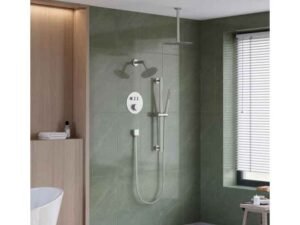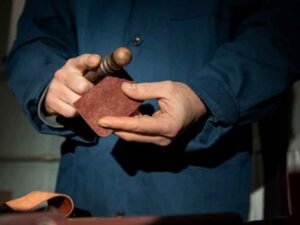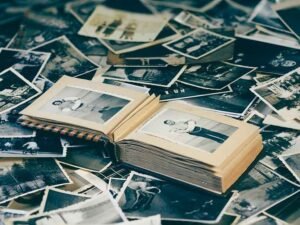What is Needle Felting?
Needle felting is a craft that involves repeatedly stabbing a needle into a piece of wool in order to stiffen and shape it into the desired form.
It is becoming a popular method for creating small animal figures since the texture of the felted creations resembles an animal’s fur.
Other popular items that felter enjoy creating include foods, plants, and cartoon characters.
A special type of needle is used to manipulate the fibers by repeatedly poking itself into the ball of wool.
The tip of the needle features small barbed notches that allow the fibers of the wool to be moved towards the center of the shape without being pulled back out when the needle is pulled out. The more this is done, the more rigid your shape will become.
Needle felting is also starting to become a popular form of stress relief, as the repeated motions of the needle can be very therapeutic.
The best thing about needle felting is that you don’t need much to get started!
What is the Difference Between Needle Felting and Wet Felting?
Needle felting, also known as dry felting, does not require the use of water to create the desired results. The result of dry felting is usually a three-dimensional object.
Wet felting combines wool fibers to create a piece of fabric using water and soap.
It can also be used to create two-dimensional artwork. Compared to other textile creation methods, wet felting is a simple technique with multiple steps involving heat, moisture, pressure, agitation, and a change in pH levels.
Nuno felting is a third technique invented in the 1990s by Australian artist Polly Stirling.
Wool is incorporated into an open weave fabric like silk chiffon to create a lightweight felt. The term “nuno” actually lends itself from the Japanese term meaning “cloth.”
Where Did Needle Felting Originate?
The History of Needle Felting
Felting, or the process of matting or interlocking wool fibers, is one of the earliest forms of textile creation.
Unlike other methods, it does not involve any weaving or spinning to create fabric out of wool. It only consists of the matting or condensing of the fibers to result in a stiff creation.
The exact history of this craft is complicated to track down due to its long-standing history. Its origin has been featured in the stories of many different cultures, including Sumerian and Greek legends.
In the 1st-3rd century Greece, it was claimed that Saint Clement and Saint Christopher discovered felting when they had packed their sandals with wool to help minimize blisters while escaping persecution.
At the end of their travels, they found that the wool had matted into felt, possibly due to the moisture and movement that had occurred.
Needle Felting in Modern Times
This craft has steadily risen in popularity over the past couple of decades. More recently, needle felted creations are a favorite among hobbyists who enjoy creating miniatures or “kawaii” figures.
It is also starting to rival the popularity of coloring books due to its therapeutic nature and the simplicity of the activity.
What Supplies Do I For Needle Felting?
This craft actually doesn’t require many supplies to get started! All you need is a needle, some wool and a piece of foam.
Needle Felting Needles
AAs previously mentioned, needle felting requires a specialized type of needle with notched tips.
These tips allow the fibers to be pulled into the center of the wool to create a stiff felt. The more you poke with a needle, the stiffer the fibers will become.
Only small rapid movements are required with the needle. You don’t need to fully insert it into the wool to agitate the fibers.
To avoid breaking the needle, it’s also essential to remove it at the same angle initially inserted. If the wool feels too stiff to insert a needle, don’t force it! Use a smaller gauge needle to finish or move to a new area.
TYPES OF FELTING NEEDLES
There are four different types of felting needles: spiral, triangular, round, and reverse felting. These are primarily based on the cross-section shape of the needle but have other characteristics that differentiate them from each other.
Spiral, triangular, and reverse felting needles are all triangular. The spiral needle features a twisted blade while the reverse felting has opposite notches that pull the fibers out of the shaped wool.
The reverse felting tool can be used as a finishing tool to manipulate the resulting texture or pull out an underlying color if needed. I wouldn’t necessarily recommend it if you are just starting, but it may be helpful if you decide to pursue this hobby further.
NEEDLE GAUGES
Felting needles are available in 32, 36, 38, 40, and 42 gauges. The higher the number, the thinner the needle. Use thicker needles for coarse wool and smaller gauges for thinner fibers. You can also use a smaller gauged needle when the wool becomes too thick.
It may be difficult to tell your needle size if you have multiple ones, so take time to color-code them if needed. I would suggest using nail polish or a small strip of colored washi tape at the handle.
FELTING NEEDLE PENS
Pens (like this one) can also help improve your process. This pen can actually hold multiple needles at once (up to 3) so that felting is more efficient.
It also has a more substantial grip, making it easier to handle. There are various tools out there to help with common needle felting issues. Experiment with different ones as you dive deeper into this craft.
WHAT IS THE BEST NEEDLE FOR NEEDLE FELTING?
Ideally, you should have multiple types of needles in various gauges. Many kits may also include more than one needle.
You can also purchase packs of needles at a pretty affordable price as you probably will end up breaking some anyway. If that’s not an option, purchasing a 38-gauge needle would be a great choice as a beginner.
The type of needle can vary based on your preference, but selecting a spiral or triangular one would be best for getting started.
Needles also come with a varying amount of notches. A higher number of grooves would allow you to felt more efficiently but may not be necessary when trying to complete more detailed work. Keep that in mind while purchasing your needles.
Needle Felting Wool
There are numerous types of fibers you can choose from for your creations. You can use animal, plant and synthetic fibers for this craft but most felters use wool from a sheep.
Different types of sheep can produce wool with varying characteristics so you may need to experiment with multiple types to find the one you like best. These may include Corriedale, Merino, New Zealand, Norwegian Lincoln, Romney, Drysdale, and many others.
Wool is usually graded in microns where the higher the micron correlates to the coarseness of the fibers.
Not only is the roughness of the fiber a factor in selecting your wool, but the method on how the wool is processed can also affect your choice.
Wool Roving vs Wool Batts
Wool is available in two primary styles: roving and batts. Roving is wool that has been brushed with special padding (also known as being carded) until the fibers are all running in the same direction.
It’s best used for spinning. Batts are sheets of thick wool that have not been fully carded and consequently have kinks of fibers running in various directions.
Both wool roving and batts are acceptable for needle felting as you will use the needle to manipulate the fiber kinks anyway. However, batts may be easier to use since the fibers are already running wild in different directions.
Best Wool for Needle Felting
Not all wool will work well for needle felting. Some are great for wet felting (like Merino wool) but may not be the best for this craft’s purposes.
Fine wool will result in a softer, silkier texture but coarser wool is actually better for needle felting as the notches on the needle will grab on to the scales on the fiber easier. This will allow you to manipulate the wool much more efficiently.
For needle felting, you’ll want to target a medium-coarse fiber. You want easy wool for the needle to hold on to but still has a smooth finish.
For beginners, you probably only need one color of the wool to get started. If you are anything like me, that’s not going to cut it. When I get excited about a new creative hobby, I want options. I want colors.
This kit actually comes with 36 different colors of 3-gram packs of Merino wool. Some prefer Merino wool for wet felting, but the set actually works well for needle felting!
Merino wool (fine-medium) – Can be used for both wet felting and needle felting
New Zealand wool (medium-coarse) – Great for needle felting, less smooth finish vs Merino
Icelandic wool (coarse, hairy) – Thel (undercoat) felts better than the tog (outer coat)
Romney wool (medium-coarse) – Has the potential to be very soft
Shetland wool (medium-coarse) – May include coarse hairs that are resistant to felting
Corriedale wool (medium-coarse) – Great for both wet felting and needle felting
Blue Faced Liecester wool (fine-medium) – Better for wet felting
Norwegian wool (medium-coarse) – Better for needle felting, more coarse than Merino and Corriedale
Needle Felting Foam
A needle felting pad or foam is used to help keep your creation grounded while working on it. It also protects surfaces (and your fingers!) from needle damage. Some felters prefer to use coarse brush.
A thick, dense piece of foam works best. You don’t necessarily need to purchase one as you can use alternatives that are found around your house.
I actually use thick foam that was leftover packaging for a whiteboard I bought!
Other Supplies
As you become more experienced, you’ll find other supplies and tools that fit your needs.
However, finger protectors may be helpful or beginners who want to avoid stabbing their fingers while needle felting.
Even if you are slow and careful, it is almost guaranteed that you’ll poke yourself!
Needle Felting Video Tutorials
How to Begin With Needle Felting?
- Slowly pull the wool by gripping it further apart. Tear a piece that is at least 1/2 an inch thicker than the shape desired.
- Roll to fibers into a ball. Do not use an excessive amount of wool. You want to layer and slowly add to your shape.
- Start to poke the fibers with the needle, ensuring that you are stabbing in an up-and-down fashion being careful not to angle the needle. You should be pulling the needle out at the same angle you are inserting it into your piece.
- Move the object around while poking with the needle to allow the fibers to felt evenly. Do not force the needle into any spots that feel firm. Move to a new area so that the shape firms uniformly.
- Keep adding layers of wool until you reach the desired amount.
- The fiber is felted once you see a smooth finish outside your shape. There should not be an excessive amount of coarse fibers sticking out.
Needle Felting Projects for Beginners
Conclusion
Needle felting is an incredibly easy craft to get into as it only requires some wool, a special needle, and maybe even some foam.
This hobby is best for those who love fiber arts or making miniatures. You can be as simple or as detailed as you’d like in your creations.
By just repeatedly poking the needle into the wool, the fibers become denser, allowing you to form various shapes.
The best needle to use for beginners would be a 38-gauge spiral or triangular needle with numerous notches but this can vary based on your personal preference.
There are tons of different options for wool, but felters tend to lean towards medium-coarse fibers as it is easier to manipulate while still leaving a relatively smooth finish.
Lastly, make sure you do your work on a thick piece of dense form to make things easier.
Are you interested in getting started with needle felting? What would you want your first creation to be? Let us know in the comments below!








